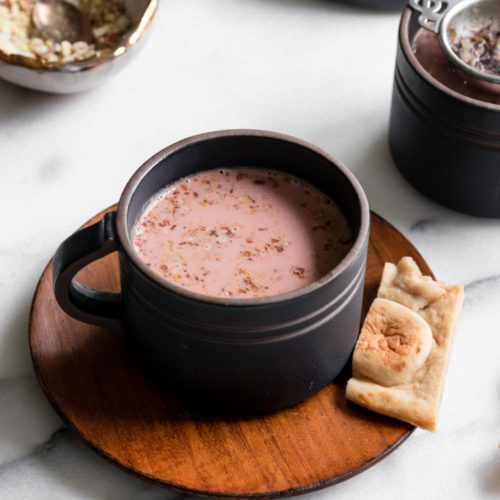When the term tea culture comes up, people usually think of places like Japan, China, or England, though perhaps Afghanistan deserves to be in this lineup too. While not as well known as those already mentioned, Afghanistan’s tea culture is a venerable one that dates back centuries. As with many ancient cultural artifacts, tea came to Afghanistan by way of the Silk Road, likely via merchants going to or from China. This tradition continues to this day, as while the country does grow some of its own tea, the majority of Afghanistan’s tea consumption relies on imports from China and Pakistan.

“National” Drink
Although tea is not officially recognized as Afghanistan’s national drink in a legislative sense, culturally it is king. Afghans commonly drink both black and green tea, often downing multiple cups a day.
In 2008, Afghanistan imported thirty tons of black tea worth $45 million USD (U.S dollars) and fifteen tons of green tea worth $12 million USD. Much of these came in the form of loose tea, or tea leaves sans any bags, and this makes sense given the country’s penchant for more traditional brewing methods. In 2018, Afghanistan was the fourteenth largest worldwide importer of tea, with their spending in this area totaling approximately $146 million USD. Part of this increase can be attributed to inflation, though it also speaks to the country’s love for its “national” beverage.
Hospitality Culture
In a way, Afghanistan’s hospitality culture is nearly inseparable from its tea culture, with the former overlapping much of the latter as in a Venn diagram. Given that hospitality is a pillar of the national character, guests are usually treated with the utmost warmth and gratitude. This can take the form of offering them a seat at one’s table, often at the head, or being liberal with refreshments. Tea is offered to both impromptu and planned guests, and to not offer tea is intended as a slight against the guest, a wordless yet unmissable signal that they are not welcome.
Furthering the connection between both of these cultures, a guest’s tea cup tends to be refilled until they themselves turn it over to indicate that they have had enough. Beyond Western style cups, which are more common in urban areas, tea is also served in mugs, shot glasses, and istakhan, which are small glass or porcelain cups not much bigger than shot glasses that also have handles.

Chai
Up to now this article has been using the word tea, as this is likely more familiar to the readership than the term typically used in Afghanistan. However, this is not to say that this other word is unfamiliar. Most people with any interest in tea have likely heard of chai before. Often this is in reference to the beverage Masala chai, a spiced milk-tea drink. Many coffee shops sell a version of this beverage under the name chai latte. The word chai has several linguistic antecedents (Hindustani, Persian, and others), but suffice it to say that due to the exchange of goods and ideas along the Silk Road, chai and phonetically similar words, rather than tea, tend to be the go-to words in and around the Middle East. Again, this is a simplification. If one traces the etymological roots of chai and tea, both lead back to China, but that is a topic deserving of its own article.
Serving Tea
Whether it is black or green, a traditional cup of tea in Afghanistan tends to be served hot and without milk. Instead, Afghans add sugar and spices like cardamom to flavor their drinks. When serving a guest, the first cup (chai shireen) is usually loaded with sugar, while the following cup (chai talkh) goes unsweetened.
On the topic of sweeteners, sugar cubes called qand are preferred by some and rather than adding them to one’s tea they are kept inside the mouth to sweeten each sip as it is drank. With cardamom, the seeds might be crushed and then sprinkled into individual cups, or thrown into a kettle or other device to infuse a whole batch of tea while it steeps.
In addition to the tea kettles commonly used in the West, samovars are another popular method of preparing tea. Widely used across Eurasia, especially in Russia and Turkey, samovars are large metal urn-shaped water heaters. Conventional models burn wood or charcoal to heat up the water contained inside them, and rather than this heat source only being below the water as with a kettle, a samovar contains a hollow tube inside the basin to store its fuel. Since they burn solid fuel, samovars also sport small chimneys to vent the smoke they produce. After the water inside the urn is heated and the fire is put out, a pot of highly concentrated tea is placed atop the chimney to heat it up. Toward the bottom of the samovar is a spout with a valve, and this is used to pour hot water from the basin into cups filled with some amount of the concentrated tea. While not as common as they once were, one can still find a brass samovar in many Afghan tea shops and personal residences.
As with other tea cultures, sweets are a common accompaniment. Sweets, or shirnee, are not always taken with tea, though they are generally brought out or sent for when serving guests. Sugar-coated almonds, pistachios, and chickpeas (all types of noql) are a mainstay when it comes to tea time snacks, yet can be seen as mundane when hosting. Cakes, cookies (biscuits), and other pastries lean more toward luxury for many Afghans. As a result, these tend to be more restricted to guests rather than everyday consumption.

Cafés and Cultures
Cafés in Afghanistan are largely patronized by young people, women, the rich, and those living in cities. Laws and customs can bar women from comingling freely with unrelated men in public spaces, though most cafés are either completely unsegregated or have an unsegregated section. These establishments are relatively new to Afghanistan, appearing mostly within the past few decades. This surge is largely credited to Westernization via access to international media (both traditional and social) and Afghans travelling for business and pleasure. The upswell in foreign aid workers and journalists in response to the ongoing War in Afghanistan, and the economic investments their presence spurred are another factor.
Some hail the increase in cafés, mainly an urban phenomenon, as a mark of progress or modernity. Public spaces like these would not have been allowed under the Taliban, so there certainly is some merit to these claims. Although, one should not be quick to generalize, to take this line of argument and stretch it the point of saying: the new tea culture is good and the old tea culture is bad.
Just as some hail Westernization, others decry it. New customs can lead to the erasure of old ones, and to argue that this is simply natural and good reveals a lopsided logic. Parts of the newer café culture are good: they give people who often previously lacked it a space to socialize and sometimes even network. But Afghan’s traditional tea culture has, as I hope this article has demonstrated at least somewhat, merits deserving of preservation. Perhaps it sounds like I have a bias toward tradition, and as a lover of history I cannot argue there is no evidence for this charge, but what I wish to communicate the most is that overgeneralization flattens reality into caricature.

Culture is complex, rarely wholly good or bad (the exception being those tent-poled by prejudice). It is usually elements that fall under these categories. Just because one element of a culture has a point in its favor does not mean another culture must be cast as its foil with the corresponding opposite value. Just because cafés can be seen in a progressive light does not automatically make traditional tea culture regressive.
Culture is also a tapestry woven from multiple strands, and just as no man is an island, no nation is immune from the influence of others. While some aspects of most every culture are indigenous, more elements than most would suspect are imported from elsewhere. Tea has not always been a part of Afghan culture. It became a part of the culture by way of Silk Road commerce. Centuries blur this distinction. Tea is not inescapably Japanese or English but a product that spawned and influenced cultures as a result of international exchange. Countries shape and mold the cultural aspects they adopt from other nations, blazing their own unique trails in the process. To point out one of these trails and say that this is the correct path for everyone is generally myopic.
Works Cited
Bedford, Emma. “Leading tea importers worldwide 2018”. Statista, statista.com, Sep 25 2020, http://www.statista.com/statistics/258620/main-import-countries-for-tea-worldwide/, Accessed Oct 10 2020
Humaira. “TEA AND HOSPITALITY IN AFGHANISTAN – QAYMAQ CHAI PARTII”. Afghan Culture Unveiled, http://www.afghancultureunveiled.com, Oct 17 2013, http://www.afghancultureunveiled.com/humaira-ghilzai/afghancooking/2013/10/tea-and-hospitality-in-afghanistan_17.html, Accessed Oct 10 2020
Kumar, Ruchi. “Cafe Culture in Kabul Shows How Afghanistan Is Transforming”. Heated, heated.medium.com, May 22 2019, heated.medium.com/cafe-culture-in-kabul-shows-how-afghanistan-is-transforming-689fbd4283ef, Accessed Oct 10 2020
Maqbool, Rafiq. “Afghan national drink, tea, good at all hours”. The Associated Press, sandiegouniontribune.com, Feb 8 2009, http://www.sandiegouniontribune.com/sdut-afghan-tea-photo-package-020809-2009feb08-story.html, Accessed Oct 10 2020
Saberi, Helen. “TEA AND HOSPITALITY IN AFGHANISTAN PART I”. Afghan Culture Unveiled, http://www.afghancultureunveiled.com, Oct 10 2013, http://www.afghancultureunveiled.com/humaira-ghilzai/afghancooking/2013/10/tea-and-hospitality-in-afghanistan.html, Accessed Oct 10 2020
Click and check out these popular articles for more information: 🙂
Circulatory System: Blood Flow Pathway Through the Heart
Ectoderm vs Endoderm vs Mesoderm
Circulatory System: Heart Structures and Functions
Ductus Arteriosus Vs Ductus Venosus Vs Foramen Ovale: Fetal Heart Circulation
Cardiac Arrhythmias: Definition, Types, Symptoms, and Prevention
Upper Vs Lower Respiratory System: Upper vs Lower Respiratory Tract Infections
Seven General Functions of the Respiratory System
Digestive System Anatomy: Diagram, Organs, Structures, and Functions
Kidney Embryology & Development: Easy Lesson
Psychology 101: Crowd Psychology and The Theory of Gustave Le Bon
Introduction to Evolution: Charles Darwin and Alfred Russel Wallace
Copyright © 2022 Moosmosis Organization: All Rights Reserved
All rights reserved. This essay first published on moosmosis.org or any portion thereof may not be reproduced or used in any manner whatsoever
without the express written permission of the publisher at moosmosis.org.

Please Like and Subscribe to our Email List at moosmosis.org, Facebook, Twitter, Youtube to support our open-access youth education initiatives! 🙂
Categories: education, History, humanities, Literature, philosophy, Social Studies, travel












![Reproductive System: Medical Anatomy and Histology of Male vs Female Reproductive Organs [Biology, MCAT, USMLE]](https://moosmosis.files.wordpress.com/2022/03/lie-72450-1614680263.jpg?w=200&h=200&crop=1)

Big fan of coffee and tea!
LikeLike
Fascinating, informative read! I definitely learned something new. Thank you for sharing, Walker.
LikeLike